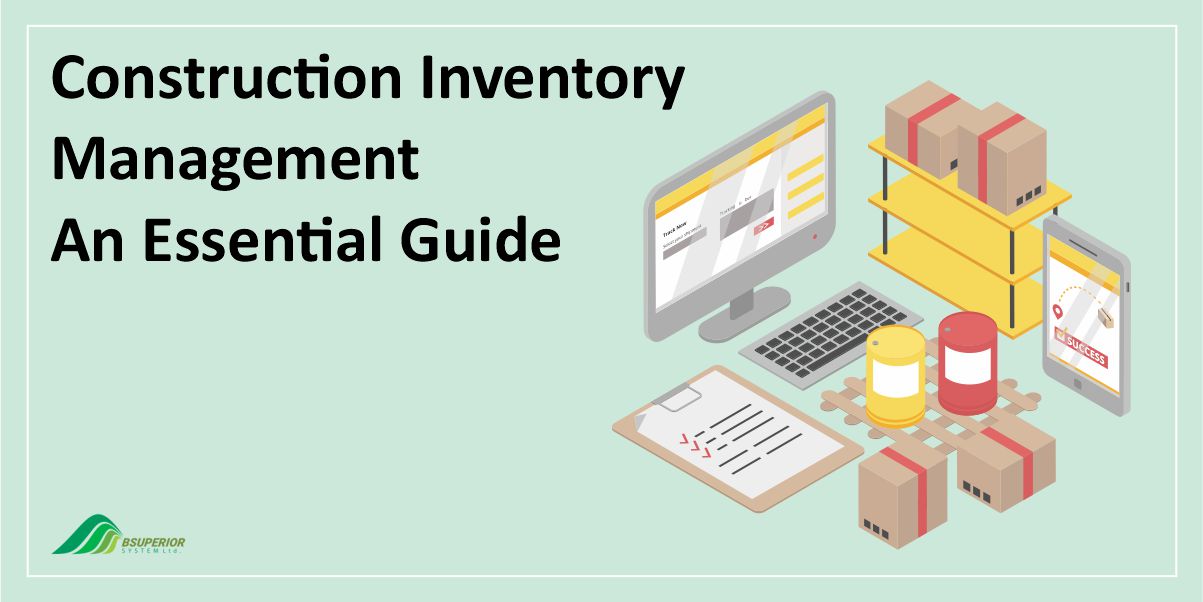Construction Inventory Management: An Essential Guide

Table Of Content
- What is Inventory Management in Construction?
- Types of Inventory in Construction
- Benefits of Construction Inventory Management
- Construction Inventory Management: Essential Features
- Construction Inventory Management: Main Challenges to Consider
- How to Improve Construction Inventory Management
- Take Control of Your Construction Inventory with BSUPERIOR
In this blog post, we’ll discuss construction inventory management systems. We’ll explore why they’re essential for any construction business and explain the key benefits they offer. We’ll also break down the core features you should look for in a system to perfectly match your project needs and maximize its effectiveness.
What is Inventory Management in Construction?
In construction, inventory management refers to the system of tracking and controlling supplies, materials, and equipment needed to complete a project.
It’s a system that helps everyone involved in a project – from business owners to contractors and suppliers – keep tabs on all the materials, tools, and equipment needed to get the job done.
This system is more than record-keeping. It helps schedule maintenance for tools and equipment to prevent unexpected breakdowns and delays. This is particularly necessary for companies juggling multiple complex projects at once.
Effective inventory management also stops you from running out of supplies or having to wait for deliveries, keeping things on schedule. Lost or misplaced items become a thing of the past, and with everything accounted for, profitability gets a boost.
Read More: Top 7 Software Solutions For Inventory Management in 2024
Types of Inventory in Construction
Construction projects require a constant flow of various supplies. These can be broadly categorized into three main groups that we explain below.
- Consumables: The first category, consumables, includes items that are either used once or wear out quickly, needing frequent replacements.
Inventory managers play a crucial role in identifying these fast-moving items and ensuring there’s enough stock for quick resupply. - Building Materials: Building materials are the heart and soul of any construction project. These are the components that become part of the finished structure.
Their procurement and delivery involve careful planning, considering factors such as availability, price, storage needs, and delivery timing. - Tools: The final category includes the tools and equipment that make construction possible. Effective inventory management for this group involves tracking, sharing, and distributing these resources across different project locations.
Benefits of Construction Inventory Management
Now, let’s delve into the real benefits that inventory management systems bring to construction businesses. Below you’ll find the main advantages that you gain by implementing this technology.
1. Increased Project Efficiency
Effective inventory management enables your construction team with ongoing control. This brings about two key benefits: readily meeting project needs while keeping costs in check.
Firstly, you’ll ensure that your team has the right materials on hand to complete jobs without unnecessary spending.
Inventory usage data becomes a valuable tool, informing you when and how much to reorder. This allows your team to fine-tune inventory levels and keep projects running smoothly.
Optimized inventory management also grants you greater visibility into leftover supplies and materials from finished jobs or those currently in storage. You can confidently place orders for new supplies and materials at the right time, knowing exactly what’s needed.
By optimizing inventory levels, your company can prevent costly overstocking and reduce waste, which is particularly important in construction, an industry inherently prone to waste.
2. Anytime, Anywhere Inventory Tracking
Tracking inventory across various remote construction sites can be a challenge. These sites often have different conditions and locations, frequently far from the main offices.
Construction inventory management software simplifies this process. Employees can easily track any type of inventory, asset, and work tool by simply scanning barcodes.
This software also allows for real-time monitoring of team activity and project updates, providing valuable insights into overall progress.
3. Sharper Project Planning
Inventory management goes beyond just keeping track of supplies. The data it generates provides a powerful tool for faster and more accurate project planning. Here’s how:
- Knowing What You Have: Inventory data reveals not only what leftover materials you can use on upcoming projects, but also a history of what gets used and what sits idle.
- Predicting What You’ll Need: This information contributes to valuable demand forecasting. You can use it to confidently adjust inventory levels at every site and in shared storage which can help you save money upfront.
- Making Informed Decisions: Inventory data combined with real-time supply chain information helps with better decision-making and risk mitigation.
For example, you can ensure critical materials with potential supply chain issues are ordered well in advance while readily available items are ordered on a regular basis.
4. Tool Tracking Made Easy
Even after a project is complete, managers need to track tool usage, condition, location, and who used it. This information is crucial for future project planning, workflow optimization, and identifying potential bottlenecks.
A good inventory management system streamlines this process and provides a central hub for all tool-related data.
5. Centralized Documentation
Construction managers often juggle multiple systems to oversee projects. Thus, a unified system for uploading and managing all project documents becomes essential.
Feature-rich inventory management systems allow you to store everything from certifications and permits to sitemaps in a single, centralized location.
This not only streamlines the entire workflow but also significantly reduces paperwork and saves time by eliminating the need to switch between multiple systems.
6. Simplified Procurement
We’ve established that construction inventory management is all about planning, project management, and material handling. But one of the biggest headaches can be running out of critical materials or tools which will cause costly delays.
Construction inventory management software tackles this problem by making sure that everything your crew needs is ready to go. This is how it works:
- Low-Stock Alerts: The software sends alerts when inventory dips below a pre-set reorder point and prompts you to replenish supplies before they run out.
- Seamless Ordering: With an inventory management system, you can create purchase orders right within the system.
- Automatic Updates: New items you order are automatically added to your inventory.
- Detailed Notes: By storing specific information about previously supplied tools and materials, you will save time and ensure that you get exactly what you need.
Read More: ERP in Supply Chain Management: Use Cases and Benefits
Construction Inventory Management: Essential Features
Selecting the perfect construction inventory management system requires careful consideration. Here, we’ll outline several must-have features that you should prioritize and explain why they’re so important.
User-Friendly Interface
A system that’s clunky, complex, or prone to crashing is a recipe for frustration and wasted time. Employees won’t be happy using a system that causes them trouble, and this can eventually hurt overall company performance.
Look for a system with:
- Intuitive navigation that’s easy to learn
- Seamless updates to avoid disruptions
- Appealing design that’s pleasant to use
- Minimal training requirements to get everyone up and running quickly
Comprehensive Inventory Tracking
Robust tracking is the heart of inventory management. The system needs to keep tabs on everything, from heavy machinery down to everyday consumables. But location isn’t enough. It should also track who’s using what, how much, when, and why.
Without this level of insight, you won’t be able to allocate resources effectively, prevent theft, or ensure projects stay on schedule and budget.
Seamless Integration
Integration with other critical systems like project management, accounting, and scheduling is crucial. Without it, you could be stuck in a maze of inefficiency, wasting time and money transferring data between systems.
Without integrations, employees resort to time-consuming manual data entry and spreadsheets which will probably introduce errors and inconsistencies.
Having said that, before purchasing, check the vendor’s website or inquire directly to ensure compatibility with your current systems.
Powerful Reporting and Analytics
Reporting and analytics features provide you with valuable insights into how your inventory is performing.
Construction inventory management software with robust reporting capabilities analyzes data on project needs, usage trends, costs, supplier performance, and procurement patterns.
This feature enables you to make informed and data-driven decisions. These systems help you work smarter by:
- Simplifying Data Interpretation: Compiling information is just the first step. Good reporting tools present data in a clear and easy-to-understand way.
- Offering Actionable Guidance: The system provides recommendations for optimizing your inventory processes.
- Facilitating Data Visualization: Charts and dashboards make it easy to see trends and identify areas for improvement.
Multi-Site Support
Construction projects often sprawl across various locations – job sites, warehouses, and offices. To maintain an organization, you need an inventory management system that adapts and tracks assets effectively, no matter where they are.
This is where multi-location support comes in. With this feature, you can:
- Monitor inventory levels across all sites simultaneously
- Prevent stockouts and overstocking more effectively
- Allocate resources efficiently based on each site’s needs
- Reduce misplaced assets and inaccurate stock counts
- Minimize excess inventory holding and transportation costs
Mobile Accessibility
Your inventory management software shouldn’t be confined to desktops. It should be accessible not just on desktops, but also on smartphones and tablets. This allows you to:
- Record inventory levels on-site
- Track material usage in real-time
- Update equipment locations via GPS
- Place orders right from your phone.
With your inventory tool at your fingertips, you’re always in the loop and ready to react quickly, just like the dynamic nature of construction projects demands.
Safety Management
It goes without saying that construction sites prioritize safety. Construction management software can help you track safety incidents, ensure compliance with regulations, and generate reports that identify areas where safety measures can be improved.
Construction Inventory Management: Main Challenges to Consider
Construction companies face a unique set of hurdles when it comes to inventory management. Unlike many industries, construction requires a vast array of constantly changing materials for each project.
Furthermore, construction’s decentralized nature, with crews scattered across different sites, adds another layer of complexity to the distribution and tracking of these materials. With that being said, let’s see what challenges you might encounter in this regard.
1. Procurement Perplexities
The first challenge arises right at the beginning of the process which is procurement. Finding reliable suppliers who deliver the right materials on time and at a fair price can be a juggling act.
While cost is always a factor, focusing solely on the cheapest option can backfire. Higher-priced suppliers might offer better quality materials and more dependable service, including on-time deliveries and accurate quantities.
Beyond supplier selection, other factors can lead to delays, such as material shortages at the manufacturer’s end or unexpected production lead times.
To mitigate these risks, plan and order materials well in advance, ideally with a two-day buffer before they’re actually needed on-site. Clear communication with your supplier is also essential to avoid miscommunication and delays in production and shipping.
2. Tracking the Multitude
A construction project’s material needs are far more than basic building supplies. Everything from lumber and screws to safety gear, office supplies, and even coffee creamer needs to be tracked and readily available.
The sheer volume of items can be overwhelming without a well-defined organization and tracking system. That’s why, precise inventory management methods are essential to maintain control over this complex environment.
3. Accountability and Avoiding Waste
Jobsite managers need consistent access to materials to keep projects moving forward. However, it’s important to strike a balance between availability and accountability in this regard.
Contractors need to hold site managers responsible for material usage and make sure that it aligns with project needs and prevents excessive ordering and waste.
Effective inventory management requires close monitoring of how many of each item is used to optimize consumption and prevent unnecessary spending.
4. Predicting Needs
Construction inventory management involves a constant game of prediction: having the right equipment, tools, and PPE (Personal Protective Equipment) on hand exactly when crews need them.
This becomes especially challenging when managing multiple sites with potentially last-minute requests. Scrambling to fulfill unexpected needs disrupts the workflow and throws off the entire inventory flow.
5. Maintaining Accurate Records
Another hurdle is maintaining accurate inventory records. Discrepancies between physical stock and what’s recorded in the system can lead to costly mistakes like overstocking or running out of critical supplies.
To combat this challenge, consider implementing cycle counting procedures. This involves continuously monitoring inventory levels at specific intervals that allow for timely identification and correction of any discrepancies.
This approach minimizes disruption to warehouse operations and reduces errors compared to full physical counts conducted all at once. By adopting cycle counting, construction companies can achieve better alignment between physical inventory and records.
Read More: 6 Best ERP For Supply Chain Management in 2024
How to Improve Construction Inventory Management
Construction sites deal with a constant flow of materials to keep projects moving. But poor inventory management can lead to wasted supplies, higher costs, and even project delays. In what follows, we provide you with a few practical strategies to optimize your construction inventory.
Plan and Anticipate
Just like any construction task, inventory management needs a plan. Digital solutions can help project managers anticipate daily needs and ensure the site is never left without critical supplies. No idle workers means a project stays on schedule.
Regular Inventory Audits
Regular checkups are essential for maintaining accurate stock levels. By physically counting inventory and reconciling it with records, construction companies can identify discrepancies, potential theft or loss, and make necessary adjustments.
Prioritize On-Time Deliveries
Delays are the enemy of progress. Set up automatic alerts when inventory levels dip low. This allows project managers to order supplies proactively and avoid disruptions to the construction schedule.
Embrace Technology
Inventory management software streamlines the entire process. From tracking stock and generating purchase orders to requesting materials and monitoring deliveries, it can all be done with a few clicks.
Available on mobile devices and web browsers, these systems enable everyone on-site to stay informed and eliminate the need for constant communication with procurement teams.
Collaborate with Suppliers
A key element of construction inventory management is fostering strong relationships with your suppliers. This collaborative approach ensures on-time deliveries and allows you to negotiate better pricing and terms.
These partnerships will significantly reduce lead times, secure more favorable pricing on materials, and thus guarantee a consistent flow of materials to keep your projects on track.
Take Control of Your Construction Inventory with BSUPERIOR
BSUPERIOR understands the ever-evolving construction landscape and takes advantage of the latest technologies to deliver cutting-edge solutions.

Our custom inventory management software goes beyond basic features by offering a user-friendly interface, a comprehensive set of tools, and seamless integration with your existing workflows.
We understand the importance of powerful software for construction inventory management, and we’re here to deliver the best inventory solutions for your business.
Ready to streamline your inventory management? Contact BSUPERIOR today and let our team of experts develop the perfect IT solution for your construction business.
We value your input and believe this content may enhance our services. However, it's under review. If you see room for improvement, please use the "Report an issue" button below. Your feedback helps us excel.
Contact us today at –– and speak with our specialist.




